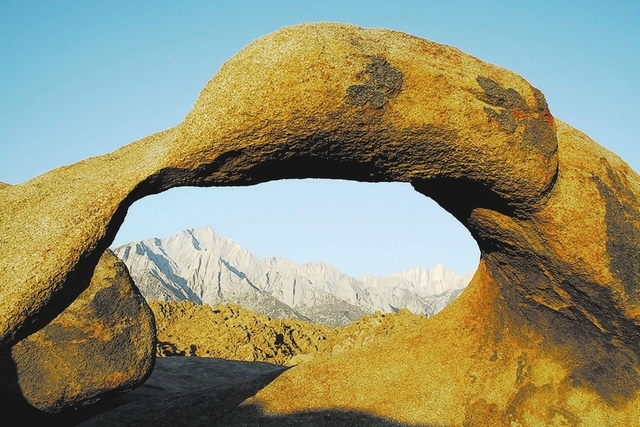Check out film history in Lone Pine


Lone Pine, Calif., is best known as a base camp to hiking, backpacking and horse packing expeditions in the eastern Sierra Nevada. It’s also a mecca to film buffs, especially those who cut their popcorn teeth on westerns. It is not only home to the Beverly and Jim Rogers Lone Pine Film History Museum but is also the site, every Columbus Day weekend, for the Lone Pine Film Festival.
Just outside of town, you will find the Alabama Hills, where the landscape, filled with oddly-shaped granite boulders, was used to shoot hundreds of scenes in films, TV westerns and commercials. The area of about 30,000 acres is now set aside as the Alabama Hills National Recreation Area.
It all began in 1919 with the filming of “The Round Up” with Roscoe “Fatty” Arbuckle. The motion picture industry kept coming back, also making use of the surrounding Owens Valley. Some of the famous feature films and television shows shot there include “Gunga Din” with Cary Grant, “The Lone Ranger” with Lee Powell, “Hopalong Cassidy” with William Boyd and, more recently, “Maverick” with Mel Gibson, “Tremors” with Kevin Bacon, and “Iron Man” with Robert Downey Jr.
The 24th Lone Pine Film Festival is set for Oct. 11-13. This year’s theme is “Lone Pine, Where the Real West becomes the Reel West.” The event includes star panels, celebrity guests, a parade, a rodeo and other entertainment. One of the highlights of the festival is taking one of the movie set tours, which takes you to locations used in filming in and around Lone Pine and the Alabama Hills.
Even if you don’t happen to make it there on festival weekend, the Beverly and Jim Rogers Lone Pine Film History Museum is worth the trip. The 10,000-square-foot building houses extensive exhibits on films and television shows and even an 85-seat movie theater. During the film festival, they plan to screen “Bad Day at Black Rock” on Oct. 11 and “Westward Ho’” on Oct. 12.
During your visit, be sure to allow time to drive the 13-mile Whitney Portal Road. It leads to a small fishing pond, a lovely cascading waterfall and also the trailhead for hikers and backpackers heading for Mount Whitney. Permits are required to do this strenuous hike. It is 10.7 miles one way, up the highest mountain in the contiguous United States, about 14,500 feet at its summit. The Whitney Portal Road is usually closed from mid-November through early May because of snow.
In October, average daily highs in Lone Pine are in the high 70s or low 80s, dipping to the high 40s at night. There are many lodging and camping choices in Lone Pine. Tuttle Creek Campground and Diaz Lake Campground, both located just a few miles outside of town, are good ones, both available on a first-come, first-served basis. For more information on the town, the museum, the festival or lodging and camping, call the Lone Pine Chamber of Commerce 760-876-4444 or visit lonepinechamber.org. For more information on the festival, call 760-876-9909 or visit lonepinefilmfestival.org.
Deborah Wall is the author of “Great Hikes, A Cerca Country Guide” and “Base Camp Las Vegas: Hiking the Southwestern States,” published by Stephens Press. She can be reached at deborabus@aol.com.












